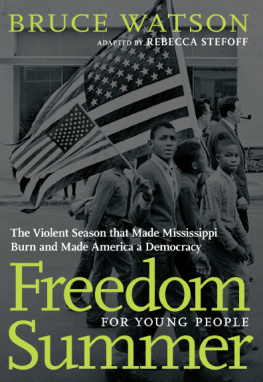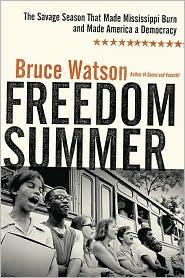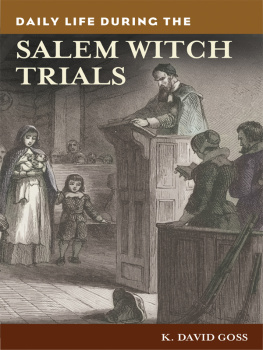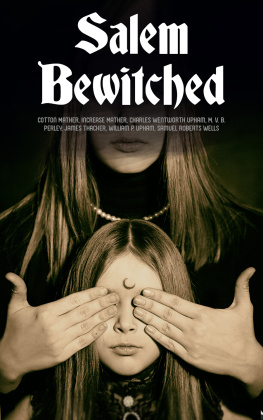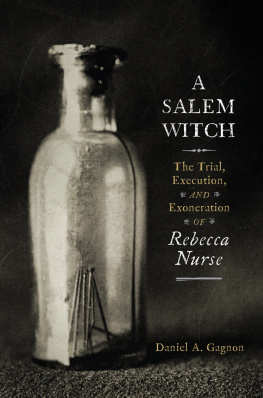Bruce Watson - Salem 1692. What Devils Made Them Do It?
Here you can read online Bruce Watson - Salem 1692. What Devils Made Them Do It? full text of the book (entire story) in english for free. Download pdf and epub, get meaning, cover and reviews about this ebook. year: 2014, publisher: New Word City, genre: Detective and thriller. Description of the work, (preface) as well as reviews are available. Best literature library LitArk.com created for fans of good reading and offers a wide selection of genres:
Romance novel
Science fiction
Adventure
Detective
Science
History
Home and family
Prose
Art
Politics
Computer
Non-fiction
Religion
Business
Children
Humor
Choose a favorite category and find really read worthwhile books. Enjoy immersion in the world of imagination, feel the emotions of the characters or learn something new for yourself, make an fascinating discovery.
- Book:Salem 1692. What Devils Made Them Do It?
- Author:
- Publisher:New Word City
- Genre:
- Year:2014
- Rating:4 / 5
- Favourites:Add to favourites
- Your mark:
- 80
- 1
- 2
- 3
- 4
- 5
Salem 1692. What Devils Made Them Do It?: summary, description and annotation
We offer to read an annotation, description, summary or preface (depends on what the author of the book "Salem 1692. What Devils Made Them Do It?" wrote himself). If you haven't found the necessary information about the book — write in the comments, we will try to find it.
Salem 1692 the name and date are synonymous with sorcery. But what caused the worst witch-hunt in U.S. history? What demons sent 20 innocent people to their deaths? Was it panic? Payback? Puritanism run amok? In this probing, brief 20-page eBook , Bruce Watson captures all the fear and fear-mongering while exploring the latest historical research into this unforgettable American tragedy.
Salem 1692. What Devils Made Them Do It? — read online for free the complete book (whole text) full work
Below is the text of the book, divided by pages. System saving the place of the last page read, allows you to conveniently read the book "Salem 1692. What Devils Made Them Do It?" online for free, without having to search again every time where you left off. Put a bookmark, and you can go to the page where you finished reading at any time.
Font size:
Interval:
Bookmark:
In witchcrafts colorful lore, one episode stands out in black and white. Black: the witchs dress and hat, the Puritan garments, and the shadows of a town hunting its own. White: the bonnets of Puritan girls, the crowd of pasty faces on Gallows Hill, a silhouetted summer moon, innocence.
Until 1692, when they swarmed out of their dens and into history, the witches were a secret all over the village. Sarah Good was a witch. Her own husband said so. Penniless, broken, she smoked a pipe and begged from house to house. If anyone refused her, the craggy old witch went away muttering, and it wasnt long before trouble darkened the door. A cow died for no reason. A child screamed as if pinched. Fever came. Sarah Good was a witch, all right. But who else had signed Satans book?
That Bishop woman, Bridget . Three husbands shed had, and still she strode around the village in that bright red bodice. She owned an inn and entertained travelers and young people, drinking and playing games, whereby discord did arise in other families, and young people were in danger to be corrupted. They said her specter came into mens houses at night and lay upon them so they couldnt breathe. All over town, there was talk.
Sarah Osborne , now there was a witch! Hadnt been to church in months and was said to be living in sin. And didnt old Martha Corey laugh at the very idea of witchcraft? One of these days, though, the witches would get their due. One of these days, the whole world would know the truth about Salem .
By February of its red year, something was gripping the young girls of Salem Village, something neither doctors nor ministers could divine. Betty Parris, the reverends own daughter, was in a trance, hands frozen in place, uttering the most hideous gargles and growls. Prayers did no good. Our father who art - set her screaming. Soon her cousin Abigail began crawling around the house, under chairs, barking like a dog, stomping her feet. Their arms, necks and backs were turned this way and that way, a minister wrote, so as it was impossible for them to do of themselves, and beyond the power of any epileptic fits or natural disease to effect.
Satan was up to his old tricks. In Boston only a few years before, the tongues of innocent children were yanked to their chins, their jaws snapped open and shut, their limbs corkscrewed like branches. A witch, old Goodwife Glover , had been tried, hung, and all was calm. Now it was Salems turn, and the fits quickly spread among the girls, only the young girls.
None dared call it witchcraft, but Salems girls, curious about their futures, were up to some mischief. Thrusting a key into a Bible, they read the verse it touched as prophecy. They made makeshift Ouija boards and read palms until Abigail Williams spread the word of a better oracle. Come to the Parris kitchen and meet Tituba . She floats an egg white in a glass. It tells your fortune. All that winter, girls met with Reverend Parris West Indian slave to learn what trade their sweethearts should be of.
Among the futures in Titubas glass, the milky shape of a coffin spread panic. Only a few weeks later, Dr. William Griggs, unable to find a medical cause for Betty and Abigails fits, declared: The evil hand is upon them! Suddenly events quickened, and the girls were no longer mere girls. Ministers surrounded them, demanding Who torments you? When the girls gave no names, names were suggested. On February 29, three women were charged with witchcraft. Then, as spring gave way to summer, Salem itself fell into a series of fits that has made its name synonymous with sorcery ever since.
More than 300 years after the most infamous witch-hunt in North America, covens of tourists still descend on Salem to hunt for history. With ongoing symposiums and exhibits, costumed Puritans walking the streets, and its own witch souvenir stores and museums, Salem has made the most of its haunted heritage. But the events Puritan minister Cotton Mather called the wonders of the invisible world remain a wonder.
For centuries, historians have branded Salems witch-hunters as hysterics, fanatics, and liars. But does anyone understand why in one hellish summer the town filled its jails, turned a bucolic knoll into Gallows Hill, hung 19 people, tortured another to death and then, only five years later hung its head in shame? If this is witch-hunting, where should the hunt begin?
Begin here: Thou shalt not suffer a witch to live - Exodus 22:18. Despite Gods commandment to Moses, witches and wizards overtly practiced their craft from Biblical times until the Middle Ages. Only when the Medieval world began to crumble in the 1400s, with scapegoats needed and power up for grabs, did the hunt began in earnest. In 1486, witch-hunting received its own bible, the Hammer for Witches. Written by two Dominican scholars with full papal approval, the book became a bestseller of sorts by explaining in painstaking detail how witches torture, possess, and kill the innocent, especially children, and how authorities should judge and execute the wicked.
In one of humanitys darkest chapters, fires blazed beneath hundreds of thousands of witches throughout the Protestant Reformation in the sixteenth and seventeenth centuries. In England, where witchcraft was a crime against the state, not the church, punishment was more merciful - hanging. In Presbyterian Scotland where the hunts were especially rabid, witches were often hung, then burned. By 1660, the worst was over in Europe. But New Englands Puritans, isolated in primeval forests, had their own demons to hunt. If ever there were witches, men and women in covenant with the Devil, thundered Salems Reverend Parris from the pulpit, here are multitudes in New England.
On March 1, 1692, most of Salem Village took a holiday. Dressed in its Sunday black and white, an overflow crowd pressed into an icy, hardwood meeting house. Two stern judges had come from Salem Town to examine the accused. Amidst commotion and gossip, they set the bewitched girls on a bench and at last brought the first witch to the bar. Sarah Good was a witch, all right. Listen.
Sarah Good, what evil have you familiarity with?
None.
Have you made no contract with the devil?
No.
Why do you hurt these children?
I do not hurt them. I scorn it.
Then why did she go away from the Reverend Parris house muttering? Muttering her commandments, she replied. She spoke in a very wicked, spiteful manner, the clerk noted, but in these grand jury proceedings, the judges needed more proof. They needed an evil eye.
Judge John Hathorne asked the girls to look at Sarah Good. Casting their eyes on the crooked woman, Betty, Abigail and their friends screamed, writhed, swooned.
Sarah Good, do you not see now what you have done? Why do you not tell us the truth? Why do you thus torment these poor children?
Clearly, something was torturing the girls. Sarah Good claimed that it was Osborne who did it. Sarah Osborne, ill and dragged out of bed into custody, claimed to be more bewitched than bewitching. In a dream, a thing like an Indian, all black, had pricked her neck and pulled her out of bed. Everyone knew Osbornes thing. He was a celebrity in Salem, cursed by every tongue, the arch-nemesis behind every form of malice. But never did goodmen and goodwives expect to see Satan torture the innocent in the Salem Village meeting house! The crowd pressed closer as Tituba stepped to the bar.
Beaten by the Reverend Parris, the slave had learned to tell Puritans what they wanted to hear. The Devil came to me and bid me serve him, she confessed. She told tales of blood red cats, red rats, witches sabbaths, and demonic creatures kept by Sarahs Good and Osborne. Satan had offered Tituba a book to sign. Sarah Goods blood red mark was in it, Sarah Osbornes, too. And when Tituba signed, she saw six more marks.
In a world half the devils, half their own, lashed by storms, ravaged by disease, haunted by natives who seemed the devil incarnate, the Puritans daily lives were the moral equivalent of war. In so fragile a world, a simple sin - malice, envy, anger, pride - opened the door for Satan and his advance guards. Witches entered bedrooms late at night. A devil had sat at Christs table, and now Titubas magic had loosed the devil among them. We are either saints or devils, the Reverend Parris preached. The scripture gives us no medium. Black or white. Once the devil entered, it was time to choose sides.
Next pageFont size:
Interval:
Bookmark:
Similar books «Salem 1692. What Devils Made Them Do It?»
Look at similar books to Salem 1692. What Devils Made Them Do It?. We have selected literature similar in name and meaning in the hope of providing readers with more options to find new, interesting, not yet read works.
Discussion, reviews of the book Salem 1692. What Devils Made Them Do It? and just readers' own opinions. Leave your comments, write what you think about the work, its meaning or the main characters. Specify what exactly you liked and what you didn't like, and why you think so.


